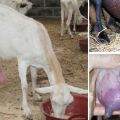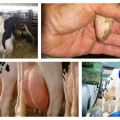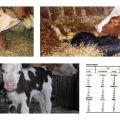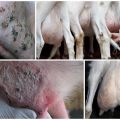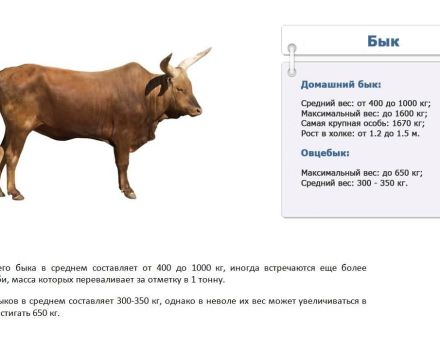What to do if a cow has lost milk and what is the reason, prevention
Keeping a cow in an individual or a farm is not only profitable, but also very responsible. The cow feeds the calves with her milk. A significant part of the most valuable product ends up on the table for people. But what if the cow gradually or suddenly lost milk? Is it possible to restore the former milk yield or will you have to send the cow for meat?
The reason for the loss
The main condition for eliminating the problem is to understand why such a disaster happened. The reasons are very diverse.
Poor nutrition
After giving birth, the animal's body must recover. The process of lactation itself, although it is customary for cows that have given birth, also requires a large set of components, which are taken with milk several times a day. Uneven feeding, periods of starvation do not immediately affect milk yield, but the depleted body of the cow will eventually fail.
Experiencing a stressful situation
The life of animals is measured and monotonous. The following unusual events can cause disruption of the body's functioning:
- long run;
- rough loading on vehicles and a long trip;
- change of owner;
- inept and painful milking;
- unusual food and furnishings.
Poor stall conditions
If in the room where the cow sleeps and stays out of grazing, there are drafts, excessively cold or hot, insufficient air, dirty and humid, the animal will inevitably reduce milk production, or even stop milking. Unsanitary conditions provoke disease. Burenka does not want to lie down in the mud and costs a lot, does not sleep enough. This exhausts the animal.
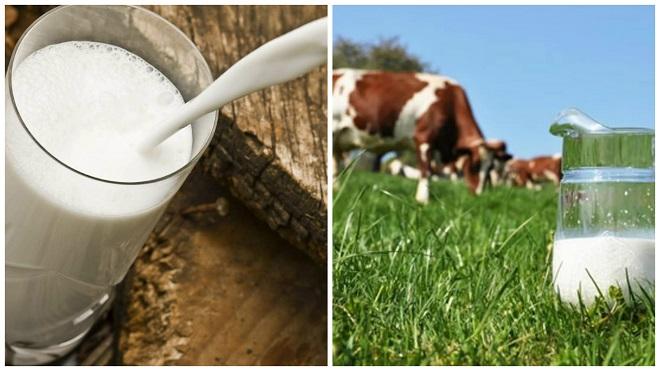
Too much cow exploitation
If the cow does not stop milking 1.5-2 months before calving, she will come to childbirth and the next lactation period weakened. It is normal for a cow to give milk 3 times a day. More frequent milking can harm her.
Udder injury and illness
Udder injury can result from a blow with a horn or a hoof, a fall, overcoming an obstacle while grazing in a forest or in an area cluttered with debris and branches. In the barn where animals are kept, shovels, boxes should not be left in order to avoid accidents.A severe bruise can lead to forced culling of the animal. The most common diseases affecting lactation are:
- mastitis;
- cracked nipples, leading to the spread of infection deep into the udder;
- inflammation of the genitourinary system;
- diseases of the digestive tract that interfere with the full assimilation of food.
What to do if a cow runs out of milk
You need to react to an empty udder instantly. As soon as the cow has stopped giving milk, a thorough examination of the animal is done, starting with the udder.
Nutrition
If no diseases are found, the cow does not show signs of weakness or agitation, the cow's diet is radically revised. Most of all, the caloric content of food affects the productivity of dairy cattle. A cow weighing 500 kg per day needs to consume 6300-6700 kilocalories for a healthy state, plus 590 kilocalories in order to produce 1 liter of milk. Such energy is provided by carbohydrates. A large amount of fiber interferes with the absorption of food.
Calorie table:
| Feed type, 1kg | Energy value, kcal |
| corn | 1894,76 |
| barley | 1597,82 |
| potatoes | 438,34 |
| sugar beet | 339,36 |
| grass | 2828 |
| carrot | 197,96 |
| fodder beets | 155,54 |
Water should always be available.

Comfortable conditions
The stable temperature is maintained at a temperature of at least 15 ° C. The floor is always dry. The manure is quickly removed. The walls are covered with dry straw. In winter, the drink is served warm and set so as not to wet the floor. There are no cracks in the walls.
Eliminating other causes
After stress, they increase nutrition and show affectionate treatment. After a day or three, it usually goes away.
If the above diseases or more alarming symptoms are detected, they contact the veterinarian.
How to prevent a problem from arising
To prevent a possible decrease in milk yield or loss of milk from a cow, it is necessary to take care of the animals constantly, not to leave them unattended for a long time. Every breeder must adhere to the rules:
- Provide cows with complete feed at the same time.
- Wash hands with soap and water before milking. Wash the udders with clean water and wipe dry with a towel.
- Inspect the cow regularly, especially after pasture.
- Prepare the first heifer in advance for milking by massaging her nipples.
- Keep the udder clean and dry, immediately treat any cracks with iodine or hydrogen peroxide. If there are no signs of healing, consult a doctor immediately.
- Do not ignore ulcers and inflammations.
- Before each milking, massage the udder for 1 minute and start milking immediately.
- Get regular veterinary examinations.
For the gentle treatment, the animal will surely thank you with increased milk yield.






